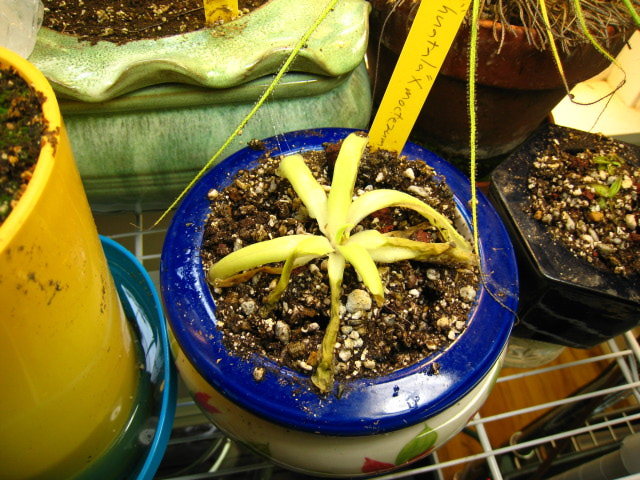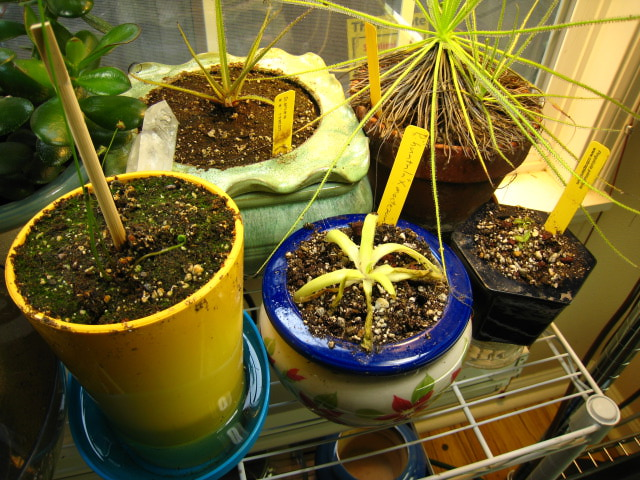Question Pinguicula huatala ?m
Pinguicula huatala ?m
 Pinguicula huatala ?m
Pinguicula huatala ?m
QUESTION: I recently repotted many of my carnivorous plants, including a Pinguicula huatala ?moctuzumae. Prior to repotting, this plant had been doing very well, having recently come out of winter dormancy (where it had mostly short, succulent-like leaves) and putting out longer leaves and also blooming with a few flowers. This was the first time repotting this particular plant since I bought it last summer. I moved it to a self-watering pot, as I have had good results with other butterworts in these pots. The soil mix I used was peat:vermiculite:perlite:pumice:lava rock:sand (all in equal proportions). Although I know that butterworts are more tolerant of minerals than other carnivorous plants, still I use only distilled water. The plant sits near a south-facing windowsill, and also I have some supplementary fluorescent lighting. After repotting, I put the plant back pretty much in the same place that it was before. About 10 days have elapsed since repotting. At first the plant looked fine, but within the last day or so it has taken a noticeable decline: several leaves have withered, and it has lost its deep green color and looks rather anemic. Is this a normal reaction to repotting, or does it need some intervention? I should mention that although the self-watering pots have worked well, I find that they occasionally can dry out as if the pores of the ceramic are not passing water through. They seem particularly prone to this when first used. That may have happened with this plant; since I noticed the problem I have been careful to make sure that the soil remains moist. Thanks for your help. Picture attached. You may notice in the photo a P. primuliflora in an adjacent pot that also has declined since being repotted.
ANSWER: It's very unusual for Mexican butterworts to behave like this after repotting. We rarely see any decline in growth after repotting. Two potential factors pop up for me - 1) improper soil, 2) trauma.
Lets start with improper soil, and there are two factors regarding this. First, the soil recipe you used is fine for Mexican butterworts. It drains well and has lots of aeration. However, it is not an appropriate soil mix for African violet pots because it drains well and has lots of aeration. The mix you have is too porous to absorb enough water through the ceramic pot. Instead, the mix is best suited for a plastic pot that you top water on a regular basis. Wtih African violet pots, you need a soil mix that will hold a bit more moisture. In this case, a standard mix of peat moss and perlite is sufficient.
The second issue with the soil is possibility of fertilizer added each soil ingredient. Check the packaging of each soil ingredient and make sure that fertilizers were NOT added. Some companies add fertilizer to their packaged peat moss and perlite. While Mexican butterworts can tolerate low dose fertilizers in the soil, if the concentration is too strong, their roots will burn, which can account for your plants' decline.
The other factor that could be affecting your plants is trauma, either from excessive handling or pests. If you disturbed the roots too much, this can set your plant back a bit or a lot, depending on the severity of root disturbance. Another possibility is soil pest biting at the roots. This might be unlikely after a recent repotting, but it is a possibility.
So the problem could be one of these issues or a combination of them. The only thing I could recommend is to check the labeling of your soil ingredients. Change the soil to better accommodate your African violet pot, or repot your plants into plastic pots. This is a good place to start to salvage the plants. If you can think of any peculiar changes that may have also occurred, please let me know.
Good growing!
Jacob Farin
---------- FOLLOW-UP ----------
QUESTION: Jacob,
Would it work if I keep the current pot/soil combination but use the African violet pots like regular pots and top water, rather than relying on the reservoir to keep the soil moist?
What about the Primrose butterworts? I have had problems in the past with rot with that plant, so I am a little reluctant to revert to a more moist soil mixture. After suffering some initial decline last year, the surviving plants stabilized over the winter and had been growing quite nicely in African violet pots with this same soil mix. After repotting, a couple look fine and some look rather ragged like the one in the photo. (Perhaps I should have left well enough alone and not repotted them in the first place, but I thought that they could use fresh soil.) It's not clear to me what the difference is; perhaps it could be just the chance variation in root trauma?
I was thinking that very small pots would be appropriate for some of the Mexican butterwort species (not necessarily the Pinguicula huatala ?moctuzumae; I'm referring to some others) as they have very shallow root systems. The primrose butterworts seem to have more substantial roots, and so might require slightly larger pots. What is your opinion about this? Would the small pots be too prone to drying out?
BTW, that is good information to know about the African violet pots generally requiring a different soil mix. You might want to add that info to your care sheets, where the use of African violet pots is mentioned.
AnswerFirst, lets deal with one issue at at time. I'm assuming that you checked the packages of your soil ingredients and confirmed that fertilizers were NOT added. You didn't mention that you did this, so I need to make sure that you did. Anything else I say won't matter if you didn't confirm that the ingredients are free of fertilizers.
Given that you have used African violet pots in the past using the same mix, the actual ratio of ingredients may not be a factor. I was under the impression that you were using this mix and African violet pots for the first time. So for now, we can safely rule out that the mix or the African violet pot isn't the issue.
Based on the information you provided, I might simply assume root trauma from repotting is the primary factor. This is common, and the plant will typically shut down the older leaves to preserve the newer growth. At this point, it's simply a matter of giving your plant time. As we progress into the growing season, your plant will produce new leaves and will look full again within a couple months.
Since root trauma seems to be the primary factor, additional repotting may not be necessary and may contribute to more root trauma. For now, keep your plants as is. Avoid adding water to the top soil in African violet pots. If you did it correctly, the soil would have been thoroughly moistened when you repotted your plants. As the moisture evaporates, water will travel through the ceramic pot. If the soil dries too quickly, add only enough water to moisten the top layer.







